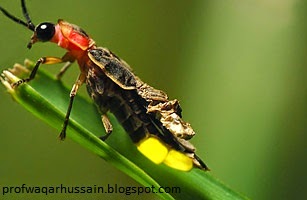Why Chameleons
Change Colours?
PROF
WAQAR HUSSAIN
.jpg) Chameleon are specialized clade of lizards
that has 600 species, many has distinctive magical property of change of colour
of their skin. Chameleons are famous for their quick color-changing
abilities for three main reasons; first, to regulate their body temperatures;
second, for social signaling and third, for camouflage.
Chameleon are specialized clade of lizards
that has 600 species, many has distinctive magical property of change of colour
of their skin. Chameleons are famous for their quick color-changing
abilities for three main reasons; first, to regulate their body temperatures;
second, for social signaling and third, for camouflage.
Heat
regulation: Since chameleons can’t generate their own body heat so they
change the color of their skin in a way to maintain optimum body temperature. Chameleons in cold weather become dark to
absorb more heat, whereas in hotter times, turn into lighter grey colour to
reflect most of the sun’s heat.
Social Signaling:
Chameleons’ changes colour to communicate their feeling. Males become bright to
signal their dominance and turn dark in aggressive mood. Males show lighter,
multicoloured patterns when courting females.
Females can let males know if they are willing to mate by
changing the color of their skin.
Camouflage: Some species adjust their colors for camouflage in accordance
with the vision of the specific predator species (bird or snake) by which they are being threatened.
Chameleons are domesticated so Owners should
know their colour language to get to their inner feeling.
How chameleon changes
their colours?
The outermost layer of
the chameleon’s skin is transparent. Beneath this are three
more layers of skins
which contain specialized cells called chromatophores. The chromatophores at
each layer are filled with sacs of different kinds of pigment.
Chromatophore
cells in the first and upper layer are called xanthophores(yellow pigment) and
erythrophores(red pigment).
Chromatophores cells
in second and middle layer are called iridophores or guanophores; these contain guanine appearing blue or white.
Chromatophores cells in the third and the
deepest layer called melanophores; contain melanin, the dark brown pigment.
These pigments
are packed in tiny sacs within the cells. When a chameleon experiences changes in body
temperature or mood, its nervous system tells specific chromatophores to expand
or contract.
For instance, an excited chameleon might turn red by fully
expanding all his erythrophores, blocking out the other colors beneath them
With these layers of
cells, some chameleons are capable of producing a dazzling array of reds,
orange, pinks, yellows, blues, greens, purple, black and browns. These bold
statements won’t help them blend into the background, but they will allow them
to get their message across to other chameleons loud and clear.
 First, the larvae of fire fly produce short glows. The adult Fireflies
produce defensive steroids in
their bodies that make them unpalatable to predators. So, the Larvae use their
glows as warning displays to communicate their distastefulness.
First, the larvae of fire fly produce short glows. The adult Fireflies
produce defensive steroids in
their bodies that make them unpalatable to predators. So, the Larvae use their
glows as warning displays to communicate their distastefulness. 



.jpg)
.jpg)

.jpg)
.jpg)

.jpg)




.jpg)

.jpg)
.jpg)

.jpg)

.jpg)
.jpg)
.jpg)
.jpg)
.jpg)
.jpg)



.jpg)


